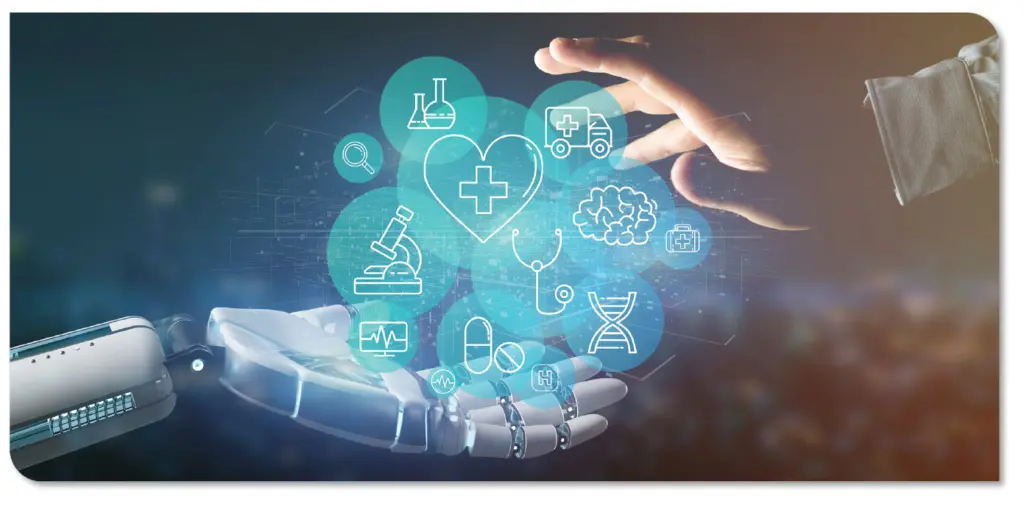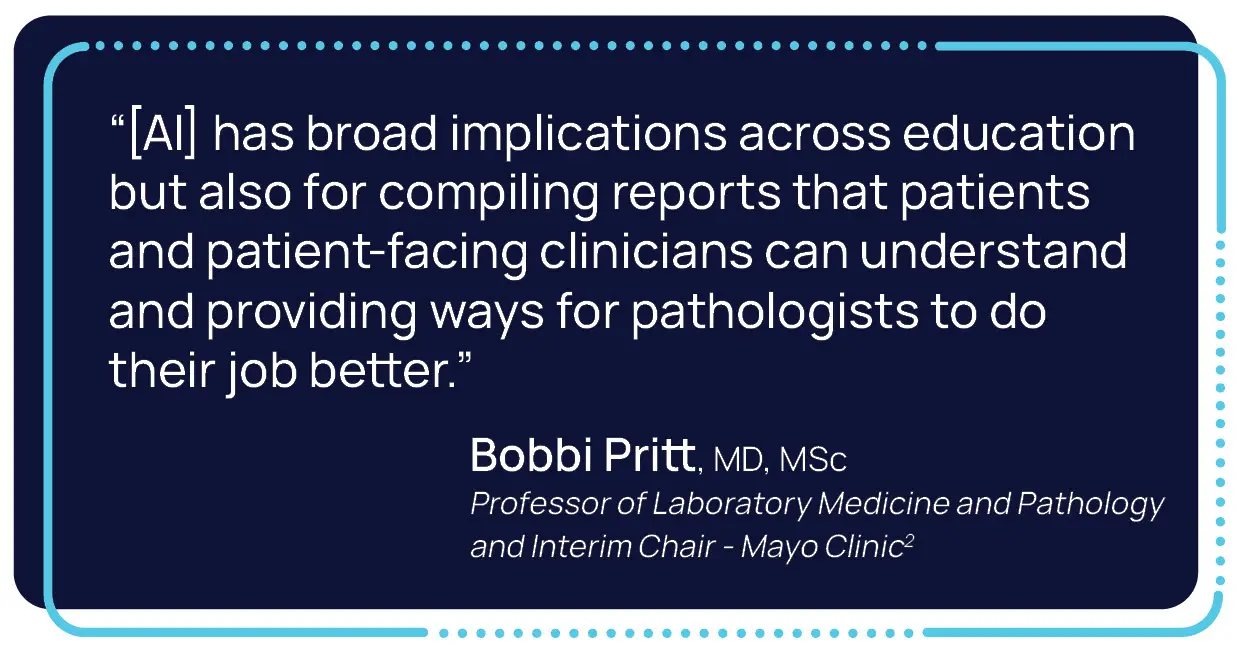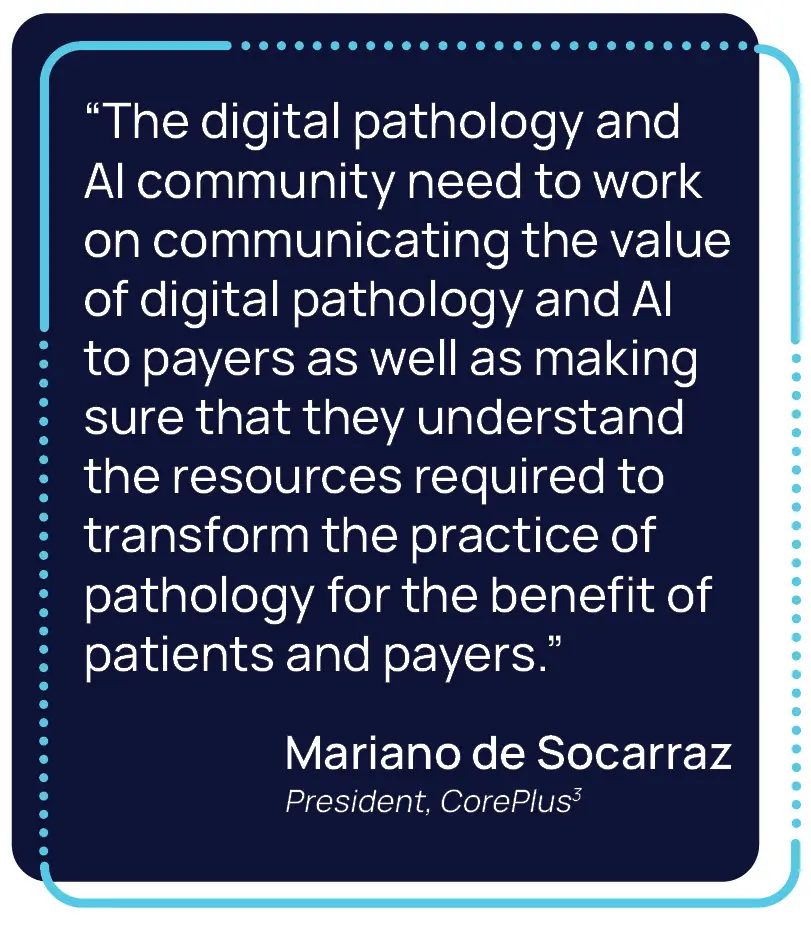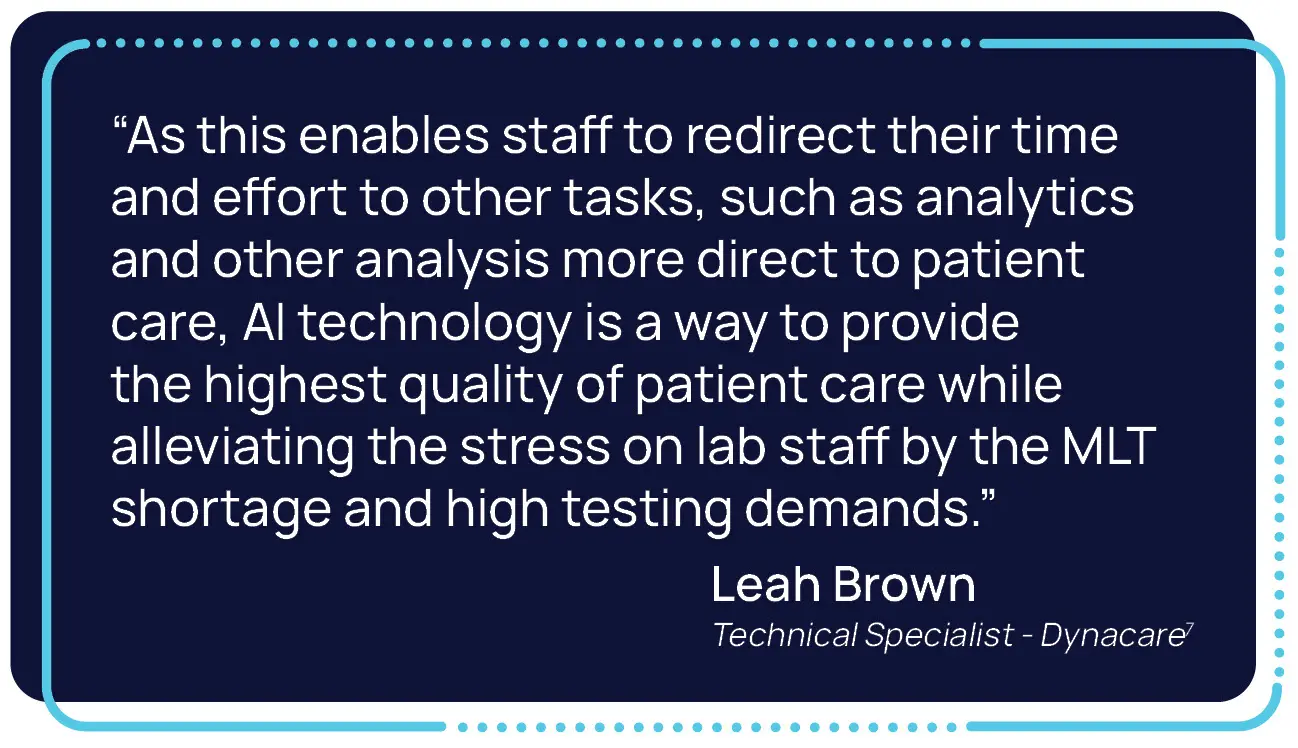The Potential of Artificial Intelligence (AI) to Enhance LIS Performance
Artificial intelligence (AI) broadly refers to the simulation of human intelligence processes by machines or computer systems. In general, AI systems work by amassing large amounts of data and analyzing that data to find correlations and patterns that are then used to make predictions.
Forms of AI, like Apple Siri and Amazon Alexa, are all around us today. Over the years, the interest and investment in AI has gradually increased. The recent release of OpenAI’s ChatGPT is a significant step toward the improvement and acceptance of AI tools.
AI is used in many types of businesses, but can be particularly beneficial in healthcare. Within laboratory information systems (LIS), AI is being implemented at a slow but steady pace and offers an exciting potential for improving lab analytics and contributing to patient care.

Executive Summary
- AI refers to the simulation of human intelligence processes by machines or computer systems.
- Tasks where humans can get fatigued by their repetitive nature are well-suited for AI tools.
- Machine learning algorithms can quickly process large amounts of data, identify patterns, and make predictions based on the data.
- Potential applications of AI in healthcare range broadly from scanning radiological and pathology images, to aiding diagnoses, to predicting outcomes from medical data.
- Because the laboratory holds an enormous amount of data, and AI can rapidly analyze large data sets, AI has great potential for the laboratory industry.
- AI in the laboratory has focused on diagnosis and therapy, but use cases are expanding and laboratories are adding new technologies to improve clinical decision-making, disease monitoring, and patient safety.
- There is great potential for innovative LIS vendors to incorporate the use of AI into the LIS.
Types of Artificial Intelligence & Their Applications
AI uses computer science to analyze large data sets for problem-solving and prediction. It includes deep learning as a subset of machine learning. These models can be broadly classified as either predictive or generative AI, with generative referring to the generation of new information. AI also includes natural language processing (NLP), which refers to the processing of human language by a computer, and computer vision, which entails a computer using a camera to see and analyze data. See Figure 1 for general categories of AI.
AI Never Gets Tired
The advantages of AI are easy to recognize. For example, tasks that might cause fatigue in humans due to their repetitive nature are well-suited for AI tools. AI does not get tired or have vision problems; it steadfastly does what it is programmed to do. AI programs do not need to sleep or take breaks; they can provide 24/7 service. AI excels at tedious, detail-oriented jobs.
AI can also reduce the time it takes to review a large set of data. AI is widely used in data-heavy industries (e.g., banking, pharmaceutical, insurance) to reduce the time it takes to analyze big data sets. AI tools deliver high levels of consistency and can personalize content, recommendations, and websites for customers.
In regard to healthcare, AI’s advantage is that it can learn from an unfathomable amount of data. For example, an AI tool that has learned how a disease presents in an imaging study can very quickly derive answers from new imaging studies.
Increasing AI Use in Healthcare
Interest in AI within the healthcare market has been around for decades, particularly in the areas of diagnostics, prognosis, and therapy selection. Thanks to an explosion in the amount of data collected and recent improvements in computational power, there are many new possibilities for AI to help improve patient care.
Potential applications in healthcare range from scanning radiological and pathology images for early detection to predicting outcomes from medical records. ML algorithms can quickly process large amounts of clinical data, identify patterns, and make predictions about medical outcomes with increasing accuracy.
AI in the Laboratory
In the 1970s, MYCIN, a computer-based consultation system, was introduced to assist with diagnosis and treatment for bacterial infections. Introduced in the early 2000s, the handheld AccuVein device uses laser technology to “see” your veins to assist in phlebotomy and IV placement. Otherwise, AI in the laboratory has largely focused on diagnosis and therapy, but use cases are expanding. Laboratory medicine continues to incorporate new AI technologies that improve clinical decision-making, disease monitoring, and patient safety.
The Department of Laboratory Medicine and Pathology within Mayo Clinic’s Center of Digital Health has a division called computational pathology and artificial intelligence (CPAI). Their CPAI department looks for ways that AI can be implemented to bring improvements across all areas of the laboratory.
Recognition of Patterns in Images
One of the strengths of AI tools is the ability to recognize patterns. This includes the ability to scan images for abnormalities. Example images are input to train the AI system to recognize features. Once training is sufficient, the algorithm can automatically bring attention to features of interest.
ML is used to recognize patterns for:
- Whole slide pathology imaging
- Cell-based imaging
- Breast cancer screening (1)
AI-assisted Pathology
In 2020, CorePlus Servicios Clínicos y Patológicos in Puerto Rico started using AI-assisted pathology for prostate cancer diagnoses. CorePlus is a full-service pathology laboratory that processes 100,000 accessions per year. They use an AI algorithm as a quality control check for digitized prostate and breast tissue slides. Since its implementation, the algorithm found 74 missed prostate cancer cases and two missed breast cancer cases. The AI tool has enhanced their ability to develop best treatment plans and increased pathologist productivity by 25%.(3)
The demand for automated laboratory recommendation systems that can assist in more accurate and faster diagnoses will continue. New AI tools that use image analysis and ML have incredible potential in pathology.
Molecular – Cancer Prognosis
Molecular diagnostics and bioinformatics require analysis of an immense amount of data. With that volume of data, AI algorithms can identify patterns and biomarkers that traditional methods cannot manage. Labs are beginning to use AI to identify molecular markers that provide targeted treatment and improve outcome prediction for acute myeloid leukemia. (4)
“[AI integration is] revolutionizing molecular diagnostics, enabling rapid, accurate analysis and heralding a new era of earlier disease detection, effective treatment monitoring, and truly personalized therapy,” said Thierry Bernard, CEO, Qiagen. (5)
Microbiology Informatics
Clinical microbiology informatics is also progressively using AI. Traditionally, identification of unknown microorganisms has been time-consuming and limited in its accuracy. ML algorithms’ ability to recognize patterns can be used to help understand microbial species and their behavior. AI can then extrapolate or predict microbial properties. AI technologies can rapidly analyze large, complex genomic and phenotypic data at a scale far beyond human capabilities. Genomic information from isolated bacteria, metagenomic microbial results from specimens, mass spectra recorded from bacterial isolates, and digital photographs are examples of enormous data sets in clinical microbiology that AI tools can analyze for diagnoses. (6)
In 2016, Dynacare in Ontario installed three walk-away specimen processors for plating urine specimens that in 2021 became part of a WASPLab© system. In 2022, they added PhenoMATRIX, Copan’s customizable AI software, to automatically pre-assess culture plates and segregate cultures. The AI system eliminates manual steps and is estimated to reduce time spent handling urine cultures by 50%. (7)
Pandemic Surveillance – Public Health
Several AI technologies have been used to track and understand pandemics such as COVID-19. AI was used during the COVID-19 pandemic for genome sequencing, vaccine development, disease outbreak monitoring, and variant tracking. With this information, public health officials are able to predict virus spread, inform the public about a pandemic situation, and predict a virus’ future route.
AI offers significant advantages over traditional disease surveillance methods because of its predictive nature. Using AI technology to identify real-time trends provides relevant insights that enable rapid outbreak responses that protect public health. This advance notice allows for a proactive, preventive approach. AI’s adaptive learning capability makes these tools superior to more traditional methods that cannot forecast outbreaks.
AI algorithms that track epidemics are capable of mining many sources of data (e.g., social media, news, flight data) to look for patterns and abnormalities that can alert public health officials. For example, EPIWATCH uses NLP that scans web data looking for terminology that could be associated with a new illness. This tool can initiate early warnings that trigger investigation of an outbreak at a time when early detection is critical. (8)
Research Implications
Google DeepMind AI lab has created a tool called AlphaFold that can analyze the chemical makeup of thousands of proteins and then use that data to make predictions about DNA substitutions that may be likely to cause disease. Genetic engineers used this tool to catalog 71 million possible missense variants, a DNA substitution where one amino acid is replaced by another. The tool was able to classify 89% as benign or pathogenic and find disease-associated genetic sequences, eventually leading to biomarker testing that can aid in earlier diagnosis. (9)
 As another example, at Northwestern University they are using AI algorithms for graph clustering to research causes of autism. The AI algorithm analyzed thousands of variants in hundreds of genes that underlie autism and identified that abnormal lipid levels define a specific autism subtype. These results signify an opportunity for early screening and intervention for this disease. (10)
As another example, at Northwestern University they are using AI algorithms for graph clustering to research causes of autism. The AI algorithm analyzed thousands of variants in hundreds of genes that underlie autism and identified that abnormal lipid levels define a specific autism subtype. These results signify an opportunity for early screening and intervention for this disease. (10)
Potential of AI Within the LIS Industry
The fact that the laboratory holds an enormous amount of data, and AI can expertly and rapidly analyze large data sets, means that AI has tremendous potential for the laboratory. ML is beginning to be adopted as a supplement to rule-based systems with tools that can interpret data using proprietary algorithms.
Predictive AI
Laboratories can use predictive AI to search for trends related to single patients or an entire population, looking for inconsistencies, outliers, or other key indicators (e.g. number of patients with abnormal test results geographic region). The use of AI from a population-studies perspective represents an enormous opportunity. For example, AI can support better definition of reference ranges, studies for complex cases that require extensive lab testing (e.g., diabetes, heart failure, pneumonia, infections, kidney disease), and risk-stratification for patients with chronic conditions.
From a lab business perspective, AI can be used to improve operational workflow. AI can algorithmically analyze data to find workflow optimizations that can reduce full-time equivalents and improve efficiencies. Using AI, in-depth analysis of staffing requirements can be achieved, allowing laboratories to determine the correct amount of staff needed based on testing volume fluctuations throughout the day. The use of AI can help alleviate the laboratory industry staffing shortage by suggesting optimizations of workflows and utilization of specialized medical technicians.
AI can map disparate data between organizational units (e.g., turnaround times) and support data standardization and modeling. It can also support sample routing and logistics. Lab leaders can use AI to justify the opening or closing of a lab location based on volumes and geographic data.
Generative AI
Using generative AI, labs can reduce the need for technical expertise to create reports and accelerate configuration and deployment. AI can be used to naturally represent questions about your system, rather than using structured query language to generate requests.
Orchard Software Innovation
At Orchard Software, we continue to look for innovative ways to improve the jobs of laboratory professionals and to provide valuable software tools that labs can use to increase their contribution to patient care.
Looking forward, we predict growth in the use of AI within the lab and within laboratory information systems. We see tremendous potential for AI to analyze the large data sets inherent to the laboratory and to improve the use of the LIS. In the future, rather than building reports and adding new locations and tests, generative AI can be used to prompt the system to perform those tasks. At Orchard, our team will continue to research and apply AI concepts in the laboratory space where they prove beneficial and add value.
Orchard Insights
While working toward broader use of AI within the LIS, Orchard Software currently offers Orchard® Insights™, a business intelligence and analytics tool that allows laboratories to effectively analyze and leverage the tremendous amount of data they manage. The analytics tool gives labs the advantage of a data-driven perspective that can help address the industry staffing shortage and improve overall laboratory productivity and efficiency. In the future, Orchard Insights will leverage predictive AI and benchmarking analytics to continue to optimize the lab’s operational efficiencies and improvements in patient care.
References
- Parker G, Sanders D. AI in the clinical laboratory: Fact or science fiction? MLO. Published July 13, 2023. https://www.mlo-online.com/information-technology/artificial-intelligence/article/53064469/ai-in-the-clinical-laboratory-fact-or-science-fiction.
- Generative AI, from education to corner cases. CAP Today. Published November 2023. https://www.captodayonline.com/generative-ai-from-education-to-corner-cases/.
- Klipp J. [Ed.]. CorePlus expands use of AI tools to routine cancer diagnosis. Laboratory Economics. Published November 2023.
- Undru TR, Uday U, Lakshmi JT, Kaliappan A, Mallamgunta S, Nikhat SS, Sakthivadivel V, Gaur A. Integrating artificial intelligence for clinical and laboratory diagnosis – a review. Maedica (Bucur). 2022 Jun;17(2):420-426. doi: 10.26574/maedica.2022.17.2.420. PMID: 36032592; PMCID: PMC9375890.
- Nadeau K. State of the industry: Molecular diagnostics. MLO. Published November 1, 2023. https://www.mlo-online.com/whitepapers/whitepaper/53076160/state-of-the-industry-molecular-diagnostics.
- Chang C. The role of AI in improving microbiology. The Microbiologist. Published September 12, 2023. https://www.the-microbiologist.com/opinion/the-role-of-ai-in-improving-microbiology/1547.article.
- Bouwers C, O’Grady G. The future is here: Artificial intelligence in the medical laboratory. Canadian Journal of Medical Laboratory Science. Summer 2022 Vol. 84, No. 2. https://www.copanusa.com/scientific-studies/the-future-is-here-artificial-intelligence-in-the-medical-laboratory/.
- Heilweil R, Fein A. AI is already tracking the next pandemic. Harvard Public Health. Published June 13, 2023. https://harvardpublichealth.org/disease/ai-services-like-epiwatch-are-already-tracking-the-next-pandemic/.
- Pocius DM. Google DeepMind says its new artificial intelligence tool can predict which genetic variants are likely to cause disease. Dark Daily. Published November 15, 2023. https://www.darkdaily.com/2023/11/15/google-deepmind-says-its-new-artificial-intelligence-tool-can-predict-which-genetic-variants-are-likely-to-cause-disease/.
- Anderson R. Artificial intelligence tool lays groundwork for autism early diagnosis and intervention. Northwestern Now. August 10, 2020. https://news.northwestern.edu/stories/2020/08/artificial-intelligence-autism.




